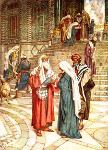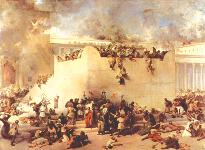Context of the New Testament (setting the scene)

There are several things that must be understood to get a clear meaning of the New Testament. First we must understand the historical context. Then we must have a clear understanding of paganism. Then we need to understand what Judaism was like.
Israel was controlled by the Roman government which controlled what was called the Greco Roman world. In general the Greco-Roman world was the area that encompassed the Mediterranean. The Greco-Roman world continued using Hellenism that was started by Alexander the Great. Hellenism was spread throughout the territories that Alexander the Great conquered. In short, Hellenism is the spread of Greek culture beyond the Greek borders. Hellenism started around 300 BCE and ended with the Roman Emperor Constantine, 300 CE.
In the Greco-Roman world it was very uncommon to meet someone who could read. Typically it was only people with money that could afford an education. Anthropologists have determined that in the best of times in the Greco-Roman world that the literacy rate was about 15%. Around the time of Christ it is believed that the literacy rate was around 10%. Typically reading a book meant that you were going to a “book reading,” which was considered an enjoyable pastime.
Life was rough in the Greco-Roman world. The infant mortality rate was staggering. Just to maintain the population a woman needed to have five children. For a woman giving birth was a very dangerous. It was not uncommon for a woman to die in the process of giving birth. Medicine was completely different than what we have today. Someone could die from an abscessed tooth. Life itself was very hard. Most people in the Greco-Roman world did not believe in an afterlife so they truly fulfilled the saying, “live for today, for there is no tomorrow.”
The Greco-Roman world was polytheistic; meaning they believed in many gods. To these people it only made sense that there was more than one god. There gods were gods that help them in the here and now. You had major deities, state deities, and family deities. The major deities were so far beyond human comprehension they didn’t interact with humans. The lesser deities were responsible for different aspects of life; rain, fertility, war, and any other aspect of life you could think of. These gods were not jealous of each other so you could have as many gods as you wanted. These gods were not concerned with beliefs but rather practices that paid tribute to them.

Most people believe that Judaism was a monolith. This means that everybody was a Jew believe the same thing. However like religions today there are many different variants to each religion. Most people have heard of the Pharisees and Sadducees but they weren’t the only Jewish sect at that time. We are well aware of the Essenes who are the people accredited with writing the Dead Sea Scrolls. There was also another group called the Fourth Philosophy (which was actually made up of several groups) also known as the Zealots, that believed that they had a religious obligation to overthrow any power that had rule over them (in this case, the Roman government). There were other groups but these were significantly smaller but these four groups made up the primary groups of Jews in that time. One would think that if you are Jewish at this time period you would belong to one of these groups, like our political system, you are either Republican, Democrate or independent, however this was not the case with the Jewish sects. These groups consisted of a very small percentage of the population, probably the low 20,000’s. When you consider the population in this time period was around 4 million this gives you an idea of what a small percentage these groups made up.
Here’s a very short summary of each group:
 - Context
- Context